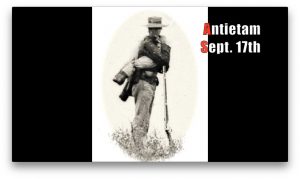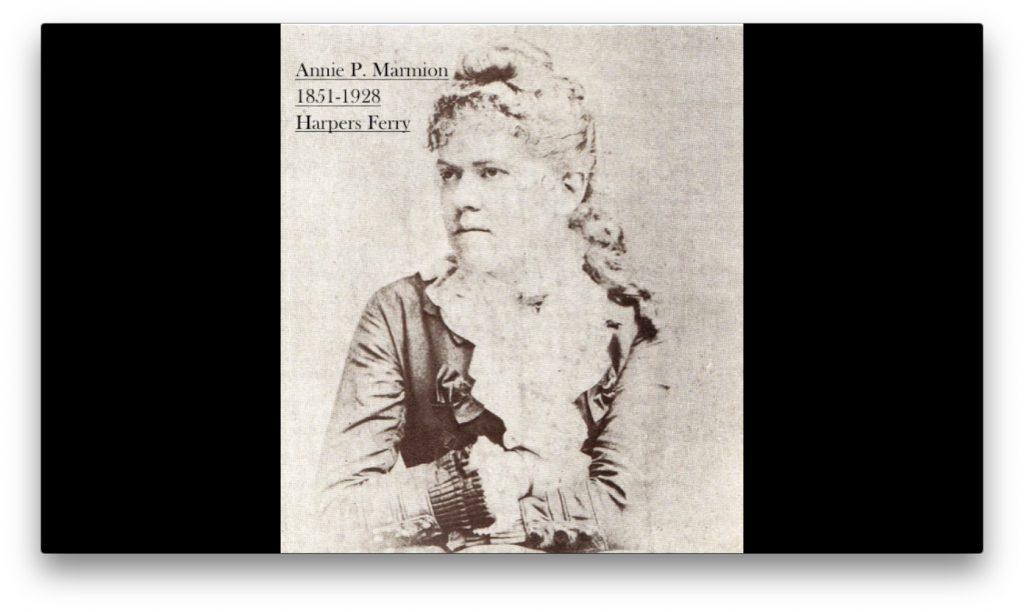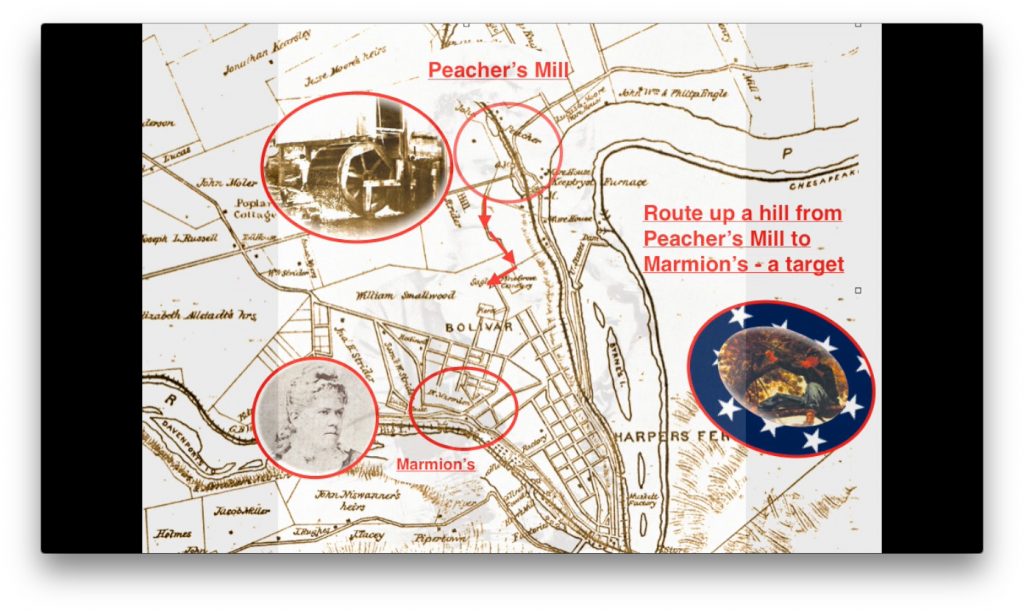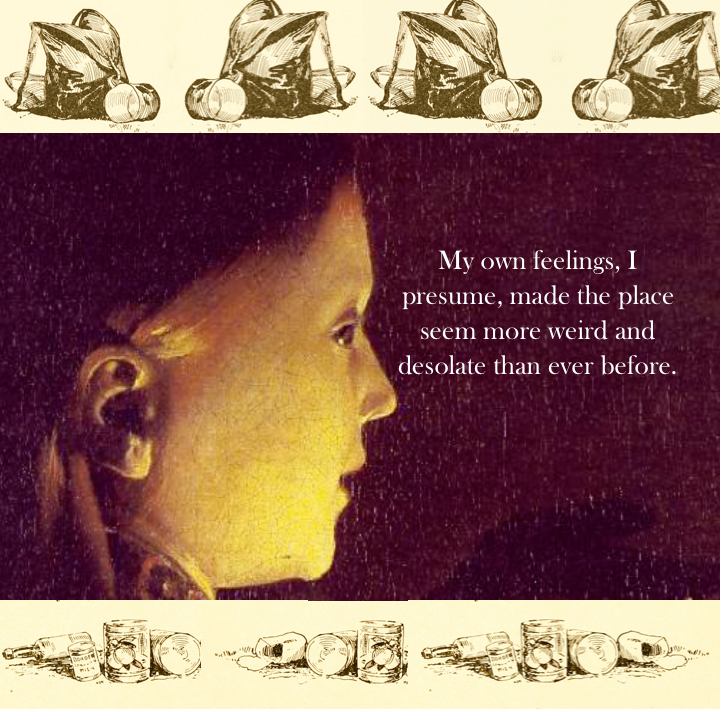by Jim Surkamp on September 7, 2016 in Jefferson County
VIDEO: The Humble Harvest, Eternal Voices – Part 1. TRT: 17:25/21:14 (incl. Credits). Click Here.
The Humble Harvest and Eternal Voices – October, 1862, Jefferson County, WV.
After a great battle,
Annie Marmion (1851-1928) wrote: But just as she passed the window best seen by the Sharpshooters, a gust of wind blew her skirts and a curtain aside. Shots immediately announced that the light had been seen.
Mary Ames and William McCarter reflect at Harpers Ferry. The result of battle shakes William McCarter’s soul: I asked how the child had been killed. With both hands, she slowly and solemnly raised the blood stained cover off the little breast, saying in sobs as she did so, “Just look here.”
Mary Ames (1831-1884): Deeds of valor are no longer dreams gone by. We live in knightly days; our men are dauntless men. Will there ever be one to write the life of the common soldier?
St. Clair Augustin Mulholland (1839-1910)sees it differently:
The regiment had not lost a man, to be sure, but had seen a genuine fight, heard the scream of the shells and seen a caisson blown up and men knocked over.
Thomas Francis Meagher (1823-1867) inspires: ”Well, you are from the Old Sod, ain’t you?”
My reply was simply, ”Yes, sir.”
Charles Aglionby (1807-1891) keeps his farm going amid war: I sent the wagon to Mr. Moore and 27 bushels by measure. The day was fine for seeding. No military to be seen on our side of the hill.
Anne Willis Ambler (1836-1888) sees all from her parents farm Rock Hall:
Wednesday, October 15th. Pa is becoming rather tired of our South Carolina soldier. Thinks he is sufficiently well to leave – and
Heros Von Borcke (1835-1895) keeps one eye out for an empty seat at a dinner table: It was a sparkling beautiful morning of autumn and I enjoyed the ride home the more for being fortunate enough – firing from my horses back with my revolver – to kill a grey squirrel, which, as our mess arrangements had been thrown into utter disorder by the events of the last two days, was gladly welcomed the same evening on our dinner table.
October 9, 1862 Weather: A pleasant day – Charles Aglionby.
Bolivar Heights, Harpers’ Ferry, Va.
Observations of Harpers Ferry October 10th, 1862 – William McCarter (1840-1911), a stammering Irish-born poet in the 116th Pennsylvania Infantry Regiment. He had worked soaking and coloring hides in Philadelphia to support his family. He wrote:
Before the war, Harper’s Ferry had a population of about 2,000. But, now like Fairfax Courthouse, Virginia, it was inhabited only by old men, black and white, women and children and a garrison of then of Union troops. The Confederate Army evacuated on the 19th of September after burning all the stores and government buildings. The Rebs left the once beautiful and comfortable town a heap of black ruins, save for a few small mean brick and log huts.
The saddest and most humiliating sight to us here, and perhaps the heaviest loss to the United States government in this section of the country, was the celebrated Harper’s Ferry Arsenal and Armory. It was now one mass of ruins, with only a small portion of the stone work standing. Our own forces had applied the fire fiend to keep it out of Confederate hands. – McCarter, p.15.
Annie P. Marmion (1851-1928), then the ten-year-old daughter of Harpers Ferry doctor, Nicholas Marmion, recalled living under martial law and even under fire that same month by the Federal authorities:
Imagine a Town filled with houses enough to accommodate over 2,000 and more than nine tenths of them empty. All metals were saleable, hence not a door in all the houses had locks or bolts of any kind. The Owls enjoyed the Open House System and joined their mournful hoots to the general slamming to emphacize the silence and loneliness. No one entered the Town except some messenger of Ill, sent always, it seems, at the night and by water from the Blockading (and sharpshooting – JS) , always the Northern Army. For weeks at a time not a wheel or tramp of a horse would be heard for everything that moved was suspected and was liable to be fired upon. . . .
The great objects in life were to procure something to eat and to keep yourself out of sight by day, and your lamps or rather candle light hidden by night, lights of every kind being regarded as signals to the Rebels were usually greeted by a volley of guns.
Groceries were luxuries not to be touched except in time of sickness but flour and meal must be had. Mills were few and far between and I wonder now where the wheat and corn came from.
Harry must go foraging and so they go. John and Queen are hitched to the farm wagon each is decorated with “the flag of Truth” as Harry calls it, as is also his hat. A flag floats from each end of the wagon, thus adorned and accompanied by one of my brothers – a lad of 12 or 13 he starts in the direction of the Southern lines in the rest of Jefferson County.
The outgoing trip is accomplished in all safety but the return late in the evening is not so fortunate. The meal, flour and some other provisions have been procured, the team has nearly reached the top of a long hill crowned with a dense woods when the Doctor on horseback joins them . . . but certain it is that a heavy and persistent fire (is) opened upon the party now in full view of the Northern Army. . . when the Doctor’s riding horse and one of his wagon horses are shot, (they) quickly get under cover of the woods and sheltering the horses, the “human element” also falls prostrate until darkness covers the earth. Then they resume and accomplish the homeward journey. The balls taking effect in the horses neck were afterwards extracted and both animals recovered. – Ibid, p. 8.
Mary Clemmer Ames (1831-1884), later a leading journalist, was caring for the wounded and burying the dead in Harpers Ferry in late, 1862. A strong woman’s rights advocate, she wrote “Eirene: A Woman’s Right” in 1872 that included these accounts of her time at Harpers Ferry. She visited the Lutheran Church on Washington Street:
The vestibule and closets of the little Lutheran church standing mid-way between Bolivar and Harper‘s Ferry, and now filled with wounded, are piled with the knapsacks and haversacks of dying and dead soldiers. I go to these and open them, take out every treasure they contain, and with a letter send them to the friends of the boy who owned them.
A little drummer boy died yesterday. I have found his haversack; it contained a picture of himself, taken with his mother when he enlisted. Such a rosy boy! I thought as I looked upon him yesterday, wasted and dead, that I was glad that his mother could never know how he changed before he died. I have sent his last message and all his things to her. The eloquence of these worm-eaten, moldy bags cannot be written. Here is the piece of stony bread, uneaten, the little paper of coffee, the smoked tin cup in which it was boiled over the hasty fire on the eve of battle; here is the letter sealed, directed, never sent; here is the letter half written, never ended, beginning “Dear wife, how I want to see you,” “Dear mother, my time is almost out;” and the rusty pen just as it was laid in the half-filled sheet by the brave and loving hand which hoped so soon to finish it. Here are scraps of patriotic poetry carefully copied on sheets of paper tinted red, white, and blue; here are photographs of favorite generals, and photographs of the loved ones at home; here are letters full of heart-breaking love and of sobbing loyalty to duty and of holy faith and cheer written to them from home; and here is the Testament given him by the woman that loved him best. Mother, these are all mementos of brave, loving life gone out. The boys who owned them will never go back. To one unfamiliar with the soldier’s life these relics might mean little.
To me they mean all love, all suffering, all heroism. Deeds of valor are no longer dreams gone by. We live in knightly days; our men are dauntless men. Will there ever be one to write the life of the common soldier? His blood buys us all that we hold dear — country, home, a free government, the endless privileges of a free people. I ask no higher privilege than to serve him living and to honor him in his grave.
It is after I have been the rounds of ward and tent that I come into this old vestibule and sit down to this sacred task. Sometimes I make up many packages. Sometimes I take up some mother’s or sister’s letter, and it brings so much back to me that I can’t go on. This was so last night. It must have been late, but I did not know it. I looked up from the contents of the knapsack which had moved me so much, and for the first time realized the appalling loneliness of my surroundings. There were the high walls of the vestibule all torn with bomb-shells, its dark open closets; its wide floor piled high with old knapsacks and haversacks, I sitting in the midst of them on a box, with no light in the place but that given by the one tallow candle at my side, which threw its feeble and flickering rays over the open bags and their contents. My own feelings, I presume, made the place seem more weird and desolate than ever before. – Ames, pp. 176-177.
Next: The Humble Harvest, Eternal Voices Pt. 2 – The Jovial Mulholland, Charlestown Skirmishing and First Blood, Aglionbys, Willis and Amblers Farm and Feed the Passing Horde
Made possible with the generous, community-minded support of American Public University System. Views in these posts and related videos do not reflect in any way the modern-day policies of the University, but are meant to encourage dispassionate, fact-based discourse on our regional and American history. More:
(1) POST – The Humble Harvest, Eternal Voices – Pt. 1 2753 words. (Repost from 5.17.2016)
(2) POST – The Humble Harvest, Eternal Voices – Pt. 2. 3058 words.
(3) POST – The Humble Harvest, Eternal Voices – Pt. 3. 2787 words.
(4) POST – The Humble Harvest, Eternal Voices – Pt. 4. 5344 words.
(5) POST – The Humble Harvest, Eternal Voices – Pt. 5 – Conclusion. 9829 words.
VIDEOS:
UPDATED: The Humble Harvest, Eternal Voices – Pt. 5 – Conclusion TRT: 29:00/53:34 (incl. Credits). Click Here.
The Humble Harvest, Eternal Voices – Part 4 – Skirmish TRT: 23:35/33:48 (incl. Credits). Click Here.
The Humble Harvest, Eternal Voices – Part 3 TRT: 14:08/26:14 (incl. Credits). Click Here.
The Humble Harvest, Eternal Voices – Part 2 TRT: 21:48/27:40 (incl. Credits). Click Here.
The Humble Harvest, Eternal Voices – Part 1. TRT: 17:25/21:14 (incl. Credits). Click Here.
References:
Charles Aglionby Papers and Civil War Diary, Volume 2 – Jefferson County Museum, Charles Town, WV.
Ames, Mary C. (1872). “Eirene, Or A Woman’s Right.” New York, NY: G. P. Putnam & Sons.
Ames, Mary C. (1872). “Eirene, Or A Woman’s Right.” googlebooks.com 5 February 2003 Web. 5 March 2016.
pp. 176-177.
Ambler, Anne W. (1971). “Diary of Anne Madison Willis Ambler (1836-1888): A Civil War Experience.” (submitted by her granddaughter, Anne Madison Ambler Baylor – Mrs. Robert Garnet Baylor). Magazine of the Historical Society of Jefferson County.” Vol. Volume XXXVII. Charles Town, WV: Jefferson County Historical Society, p. 29.
Frye, Dennis E. (2012). “Harpers Ferry Under Fire: A Border Town in the American Civil War.” Harpers Ferry, WV: Harpers Ferry Historical Association. Print.
Marmion, Annie P. (1959).”Under Fire: An Experience in the Civil War.” William V. Marmion, Jr. editor. self-published. pp. 8-9;
McCarter, William. (1996). “My Life in the Irish Brigade – The Civil War Memoirs of Private William McCarter, 116th Pennsylvania Infantry.” edited by Kevin E. O’Brien. Cambridge, MA: Perseus Books Group. p. 15; pp. 21-22;
McCarter, William. (1996). “My Life in the Irish Brigade – The Civil War Memoirs of Private William McCarter, 116th Pennsylvania Infantry.” googlebooks.com 5 February 2003 Web. 5 March 2016.
Mulholland, St. Clair Augustin. (1899). “The story of the 116th Regiment, Pennsylvania Infantry. War of secession, 1862-1865.”
[Philadelphia, F. McManus, jr., & co.]
Mulholland, St. Clair Augustin. (1899). “The story of the 116th Regiment, Pennsylvania Infantry. War of secession, 1862-1865.” Archives: Digital Library of Free Books, Movie, Music and Wayback Machine. 27 Oct. 2009. Web. 16 Feb. 2011.
Von Borcke, Heros. (1867). “Memoirs of the Confederate war for independence.” Philadelphia. PA: J. B. Lippincott & Co. Print.
Von Borcke, Heros. (1867). “Memoirs of the Confederate war for independence.” Internet Archives: Digital Library of Free Books, Movie, Music and Wayback Machine. 27 Oct. 2009. Web. 16 Feb. 2011.
pp. 309-317.
Image Credits:
Mary Ames – frontispiece – From a New England Woman’s Diary in Dixie in 1865.
Annie Marmion – from book’s frontispiece
St. Clair Mullholland – from book’s frontispiece
William McCarter – from book’s frontispiece
Charles Aglionby – from Vol. 2, Aglionby Papers, Jefferson County Museum
Charles Town, WV
detail, Thomas F. Meagher – The Huntington Library, San Marino, California.
Heros Von Borcke – civilwarscholars.com 9 June 2011 Web. 10 May 2016.
Billings, John Davis. (1887). “Hardtack and coffee.”:
a haversack and dipper (p. 276); cans and bottles
Paintings:
James Wells Champney –
The Little Beggar
the-athenaeum.org 23 May 2002 Web. 10 May 2016.
The Letter (also known as Mr. and Mrs Samuel Colgate)
the-athenaeum.org 23 May 2002 Web. 10 May 2016.
Workboats and Waterman in the Civil War (detail).
obxentertainment.com 28 December 2008 Web. 10 May 2016.
Champney from King, Edward. (1875). “The Great South; A Record of Journeys in Louisiana, Texas, the Indian Territory, Missouri, Arkansas, Mississippi, Alabama, Georgia, Florida, South Carolina, North Carolina, Kentucky, Tennessee, Virginia, West Virginia, and Maryland.” Illustrated by Champney, James Wells. Hartford, Conn. American Publishing Co. Print.
Champney from King, Edward. (1875). “The Great South; A Record of Journeys in Louisiana, Texas, the Indian Territory, Missouri, Arkansas, Mississippi, Alabama, Georgia, Florida, South Carolina, North Carolina, Kentucky, Tennessee, Virginia, West Virginia, and Maryland.” docsouth.unc.edu 20 June 2002 Web. 10 May 2016.
The negro nurses (p. 30), country wagons (p. 557).
Edward Lamson Henry –
Good Morning;
On the Way to Market
the-athenaeum.org 23 May 2002 Web. 10 May 2016.
http://www.the-athenaeum.org/art/detail.php?ID=58222
Godfried Schalcken – Young Girl with a Candle
the-athenaeum.org 23 May 2002 Web. 10 May 2016.
Winslow Homer – The Sharpshooter on Picket Duty, 1863.
the-athenaeum.org 23 May 2002 Web. 10 May 2016.
Georges De La Tour –
The Dream of St Joseph – detail, 1640, Musee des Beaux-Arts, Nantes.
the-athenaeum.org 23 May 2002 Web. 10 May 2016.
The Repentant Magdalen
wikipedia.org 27 July 2001 Web.10 May 2016.
Petrus van Schendel – By the Candlelight
the-athenaeum.org 23 May 2002 Web. 10 May 2016.
wvgeohistory.org 5 October 2010 Web. 10 May 2016.
Maps – Howell Brown, Jefferson County, 1862; Jefferson County Land Grants;
Images from wikimedia.org (24 July 2003 Web. 10 May 2016); or wikipedia.org (27 July 2001 Web.10 May 2016):
Map_of_West_Virginia_highlighting_Jefferson_County
Wapcaplet – based on Image:Map of USA without state names.svg
nationalatlas.gov: National map with state boundaries
Union Patriotic Cover Allegory of Standing Liberty and Flag mailed from Westchester, PA.
Harpers Ferry from Maryland Heights showing Marmion Block
American Flag July 4, 1861 – July 3, 1862
Loudoun County in the American Civil War
German tanning operation about 1880
Period painting of a US Civil War soldier, wounded by a Minié ball, lies in bed with a gangrenous amputated arm.
Online Library of Congress:
detail (man with coffee cup) Army of the Potomac — the way they cook dinner in camp
loc.gov 7 September 2010 Web. 10 May 2016.
Map of Jefferson County, Va. 1852 loc.gov 7 July 2012 Web. 10 May 2016.
[Harper’s Ferry, W. Va. Ruins of arsenal] loc.gov 29 November 2010 Web. 10 May 2016.
http://www.loc.gov/pictures/resource/cwp.4a39558/?co=cwp
Burial of the Union dead at Fredericksburg, December 15, 1862 (i.e. May 19 or 20, 1864. Working within the Confederate lines under a flag of truce. Our army had retreated, leaving our dead on the field. loc.gov 19 February 2012 Web. 10 May 2016.
detail [Spotsylvania Court House, Va., vicinity. Burial of soldier by Mrs. Alsop’s house, near which Ewell’s Corps attacked the Federal right on May 19, 1864]. loc.gov 16 June 1997 Web. 10 May 2016.
(extreme detail. soldier in rear, right background) A lone grave on battle-field of Antietam loc.gov 14 September 2015 Web. 10 May 2016.
A contrast! Federal buried, rebel unburied, where they fell at the Battle of Antietam
taken by Alexander Gardner. http://www.loc.gov/pictures/ 17 January 2010 Web. 10 May 2016.
Liljenquist Family Collection of Civil War Photographs (LOC):
[Unidentified girl in mourning dress holding framed photograph of her father as a cavalryman with sword and Hardee hat]. loc.gov 12 December 2010 Web. 10 May 2016.
[Private James W. McCulloch of Co. E, 7th Georgia Infantry Regiment holding wooden canteen, with lock of hair, obituary, and poem in case]. loc.gov 23 November 2014 Web. 10 May 2016.
Harper’s Weekly 1861 – May 11, 1861; July 6, 1861 & July 20, 1861:
sonofthesouth.com Start date unavailable Web. 10 May 2016.
Harpers Ferry Covered Bridge, blown up by Confederate Army on June 14, 1861.
Arsenal Fire
Lt. Roger Jones
civilwarscholars.com 9 June 2011 Web. 10 May 2016.
Nicholas Marmion – National Park Service at Harpers Ferry (NPSHF) – Frye, Harpers Ferry Under Fire, p. 155.
boy with hat, p. 801.
Crayon, Porte (Strother, D. H.). “The Mountains. Pt. II.” Harper’s New Monthly Magazine, New York, NY: Harper and Bros. Volume 44, Issue: 264, May, 1872. pp. 801-815. Print
Crayon, Porte. (May, 1872). “The Mountains. Pt. II.” Harper’s New Monthly Magazine. Cornell Digital Library – The Making of America. 28 August 2004 Web. 29 January 2014.
kids in bushes, p. 347.
Crayon, Porte (Strother, D. H.). “The Mountains. Pt. IV.” Harper’s New Monthly Magazine, New York, NY: Harper and Bros. Volume 44, Issue: 267, August, 1872.
Crayon, Porte.. (August, 1872). “The Mountains. Pt. IV.” Harper’s New Monthly Magazine. Cornell Digital Library – The Making of America. 28 August 2004 Web. 29 January 2014.
detail Camp of 110th Pennsylvania Inf’y – civilwartalk.com 17 August 2000 Web. 10 May 2016.
Great Horned Owl in old barn window – Mark Duffy
Single Bag Knapsack – missouribootandshoe.tripod.com 11 October 2003 Web. 10 May 2016.
Stained Glass Church Cathedral Abbey Windows Vibrant and Colorful Late 1800s French Chromolithograph
detail (face and shoulders) – “Gangrenous ulcer on external side of left foot resulting from gunshot wound.” Private John D. Parmenter, Co. G, 67th Pennsylvania Volunteers, was wounded at Amelia Springs, VA on April 6, 1865 during the American Civil War. – National Museum of Health and Medicine archives. flickr.com 26 February 2004 Web. 10 May 2016.



















